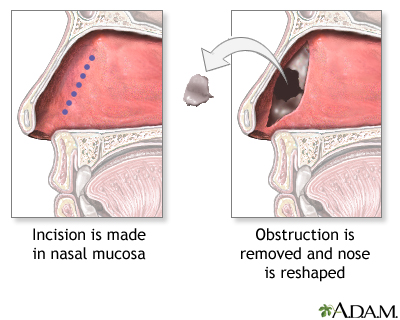Health Library
Septoplasty - series

Normal anatomy
The septum is the cartilage and bony partition that separates the two nasal chambers (nostrils).

Indications
The main indications for nasal surgery are:
- Nasal airway obstruction
- Septal spur headache
- Uncontrollable nosebleeds
- Nasal septal deformity in the presence of other intranasal surgery
Nasal airway obstruction is usually the result of a septal deformity that causes breathing by mouth, sleep apnea, or recurrent nasal infections that are slow to respond to antibiotics.
A septal spur headache is defined as a headache secondary to pressure from the nasal septum on the linings in side the nose (septal impaction) and relieved by topical (applied to a localized area of the skin) anesthesia on the septal impaction.
Other intranasal surgery indicating septoplasty includes polypectomy (removal of a polyp), ethmoidectomy (operation on the ethmoid bone at the superior part of the nasal cavity), turbinate surgery (operation on the concha nasalis), and tumor removal.

Procedure
The goal of the surgery is to straighten out the nasal septum, to relieve obstructions, or other problems related to the deviation of the septum. An incision is made internally on one side of the nasal septum. After the mucous membrane is elevated away from the bone, obstructive parts of bone and cartilage are removed, and plastic surgery is performed as necessary. Then the mucous membrane is returned to its original position.

Aftercare
Other intranasal surgery indicating septoplasty includes polypectomy (removal of a polyp), ethmoidectomy (operation on the ethmoid bone at the superior part of the nasal cavity), turbinate surgery (operation on the concha nasalis), and tumor removal.
Related Information
RhinoplastySeptoplasty
BACK TO TOP
Review Date: 3/2/2023
Reviewed By: Tang Ho, MD, Associate Professor, Division of Facial Plastic and Reconstructive Surgery, Department of Otolaryngology – Head and Neck Surgery, The University of Texas Medical School at Houston, Houston, TX. Also reviewed by David C. Dugdale, MD, Medical Director, Brenda Conaway, Editorial Director, and the A.D.A.M. Editorial team.
 | A.D.A.M., Inc. is accredited by URAC, for Health Content Provider (www.urac.org). URAC's accreditation program is an independent audit to verify that A.D.A.M. follows rigorous standards of quality and accountability. A.D.A.M. is among the first to achieve this important distinction for online health information and services. Learn more about A.D.A.M.'s editorial policy, editorial process and privacy policy. A.D.A.M. is also a founding member of Hi-Ethics. This site complies with the HONcode standard for trustworthy health information: verify here. |
The information provided herein should not be used during any medical emergency or for the diagnosis or treatment of any medical condition. A licensed medical professional should be consulted for diagnosis and treatment of any and all medical conditions. Links to other sites are provided for information only -- they do not constitute endorsements of those other sites. No warranty of any kind, either expressed or implied, is made as to the accuracy, reliability, timeliness, or correctness of any translations made by a third-party service of the information provided herein into any other language. © 1997- 2024 A.D.A.M., a business unit of Ebix, Inc. Any duplication or distribution of the information contained herein is strictly prohibited.
